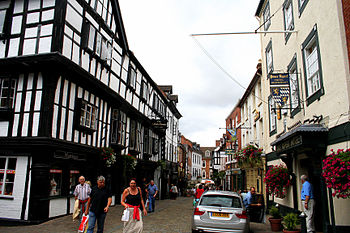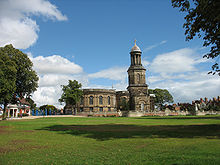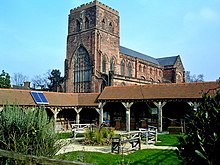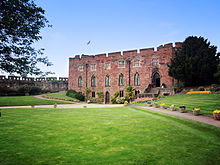Shrewsbury
![]()
This article is about the town of Shrewsbury in England. For other places of the same name, see Shrewsbury (disambiguation).
Shrewsbury (![]()
![]() [ˈʃroʊzbri] or [
[ˈʃroʊzbri] or [![]()
![]() ˈʃruːzbri]) is a town in the West Midlands in England, located about 60 kilometres (25 mi) west-northwest of Birmingham and 14 kilometres (14 mi) east of the border with Wales. Its medieval core lies in a loop of the River Severn. The town is the historic administrative seat of the county of Shropshire and, since 2009, the administrative seat of the newly formed Shropshire Council. The city has about 71,700 inhabitants (as of 2011).
ˈʃruːzbri]) is a town in the West Midlands in England, located about 60 kilometres (25 mi) west-northwest of Birmingham and 14 kilometres (14 mi) east of the border with Wales. Its medieval core lies in a loop of the River Severn. The town is the historic administrative seat of the county of Shropshire and, since 2009, the administrative seat of the newly formed Shropshire Council. The city has about 71,700 inhabitants (as of 2011).
The present town is a centre for culture and commerce. The retail sector has a large customer catchment area, including neighbouring Powys in Wales. Several business parks and retail parks are located on the outskirts of the town. The town is a major junction of trunk roads into Wales and of five railway lines.
History
The earliest human evidence at the loop of the River Severn dates back more than 10,000 years.
It is possible that the Romans already founded a settlement on this site, a few kilometres from the town of Viroconium (Wroxeter). But the actual founders of the town are considered to be the Anglo-Saxons. Shrewsbury is said to have been founded in the 8th century (however, an exact date has not survived). The earliest documented mention was in 901, when Shrewsbury was part of the Kingdom of Mercia. The town had its own mint and was governed by a corporation for several centuries.
After the Norman conquest of England, Shrewsbury and the county of Shropshire became an important line of defence against the Welsh. Roger de Montgomery, a relative of William the Conqueror, was entrusted with the control of the county. His job was also to watch William's back in the fight against the rebellious north. In 1083 Roger de Montgomery founded the Benedictine monastery of Shrewsbury, and in 1094, a few weeks before his death, he entered the order. He was buried in the abbey church, where his tombstone can still be seen today.
In 1137 the bones of Saint Winefride were transferred from Wales to Shrewsbury, where they remained until the destruction of the abbey by Henry VIII. Prior Robert Pennant, later Abbot, was instrumental in the transfer of the bones and wrote a book about the event.
In 1138, during the War of the English Succession, there was a fierce battle for Shrewsbury Castle. The besiegers under King Stephen were victorious and occupied the castle. From then on Shrewsbury was "loyal to the king". The present castle was built much later.
A few miles to the north, at what is now the suburb of Battlefield, the Battle of Shrewsbury took place in 1403. This battle ended the rebellion of Henry Percy of Northumberland against King Henry IV and claimed more than 20,000 lives. During the English Civil War, Shrewsbury was a Royalist stronghold and only fell to Parliamentary troops when they were let through one of the town gates by a traitor. This gate, St Mary's Water Gate, is also known today as Traitor's Gate.
Shrewsbury is off the main trade routes and did not grow nearly as fast as most other English towns during the Industrial Revolution. Only a few factories were built here. Between 1830 and 1840 the population actually declined, mainly because of the lack of industry and poor transport links. By the end of the 19th century, the railway was the town's main employer. During the Second World War, Shrewsbury was spared from hostilities. Today, the town still has little industry, but the service sector and tourism play an important role. Shrewsbury is the headquarters of the 5th Division of the British Army.
To this day, even old-timers argue about the correct pronunciation of the name Shrewsbury. You can pronounce the name Shruesbury (long u), as well as Shrowsbury (ou).

City coat of arms

Typical architecture in Shrewsbury on Butcher Row
Population
The 2001 census counted a population of 67,126; the current population is estimated at around 70,000. Shrewsbury is thus the second largest town in the county of Shropshire in terms of population density, smaller than the planned town of Telford and larger than the historic town of Oswestry in north-west Shropshire. In 2000 and 2002, the town of Shrewsbury applied for City status, but without success. Shrewsbury is the second largest town in the ceremonial county after its autonomous neighbour Telford, whose former county borough of Shrewsbury & Atcham had a population of 95,850.

St. Chads Church next to the city park The Quarry

Gothic abbey church

Shrewsbury Castle
Questions and Answers
Q: Where is Shrewsbury located?
A: Shrewsbury is located in Shropshire, a county of England, 9 miles (14 km) east of the Welsh border.
Q: When was Shrewsbury established as a town?
A: Shrewsbury was started around 700 AD.
Q: What is the significance of the listed buildings in Shrewsbury?
A: The listed buildings in Shrewsbury have timber framing from the 15th and 16th centuries, providing historical and architectural significance for the town.
Q: What historical structures are in Shrewsbury?
A: Shrewsbury Castle, built in 1074, and Shrewsbury Abbey, built in 1083, are historical structures in Shrewsbury.
Q: Who is a notable person associated with Shrewsbury?
A: Charles Darwin was born in Shrewsbury and lived there for 27 years.
Q: What is the population of Shrewsbury?
A: The population of Shrewsbury is just over 71,000, making it the second largest town in Shropshire.
Q: What are some of the amenities in Shrewsbury?
A: Shrewsbury has a railway station and a professional football club, Shrewsbury Town, who compete in League One, as well as a variety of listed buildings and historical structures.
Search within the encyclopedia